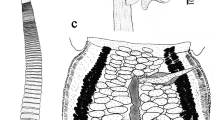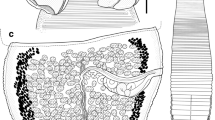Abstract
New collections of tapeworms from the carcharhinid shark species Carcharhinus cf. dussumieri (Müller & Henle), the whitecheek shark, in the Persian Gulf have yielded two new species belonging to the tetraphyllidean genus Paraorygmatobothrium Ruhnke, 1994 (Phyllobothriidae). Both new species resemble the subset of Paraorygmatobothrium species that bear gongylate columnar spinitriches, rather than serrate gladiate spinitriches, on their distal bothridial surfaces. In combination, their shorter lengths, smaller number of testes and smaller bothridial apical suckers distinguish both Paraorygmatobothrium mobedii n. sp. and Paraorygmatobothrium sinuspersicense n. sp. from all but two of their congeners. They conspicuously differ from P. exiguum (Yamaguti, 1935), in that the spinitriches on their distal surfaces are not arranged on ‘bumps’ and from P. filiforme (Yamaguti, 1952) in their possession of fewer proglottids. The two new species differ from one another in cirrus-sac shape, testicular shape and arrangement, and vitelline follicle arrangement (i.e. 2 vs 4–6 follicles in each lateral band). In addition, statistically significant differences were seen in terminal proglottid length, ovarian length and apical sucker diameter. This brings the total number of species of Paraorygmatobothrium to 14, and extends the number of carcharhiniform host genera known to host members of the genus to seven. This is also the first description of tapeworms from an elasmobranch in the Persian Gulf.




Similar content being viewed by others
References
Caira, J. N., & Durkin, S. M. (2006). A new genus and species of tetraphyllidean cestode from the Spadenose shark, Scoliodon laticaudus, in Malaysian Borneo. Comparative Parasitology, 73, 42–48.
Chervy, L. (2009). Unified terminology for cestode microtriches: a proposal from the participants of the International Workshops on Cestode Systematics in 2002–2008. Folia Parasitologica, 56, 199–230.
Cutmore, S., Bennett, M. B., & Cribb, T. H. (2009). Paraorygmatobothrium taylori n. sp. (Tetraphyllidea: Phyllobothriidae) from the Australian weasel shark Hemigaleus australiensis White, Last & Compagno (Carcharhiniformes: Hemigaleidae). Systematic Parasitology, 74, 49–58.
Malek, M., Haseli, M., Mobedi, I., Ganjali, M. R., & Mackenzie, K. (2007). Parasites as heavy metal bioindicators in the shark Carcharhinus dussumieri from the Persian Gulf. Parasitology, 134, 1053–1056.
Reyda, F. B. (2008). Intestinal helminths of freshwater stingrays in Southeastern Peru, and a new genus and two new species of cestode. Journal of Parasitology, 94, 684–699.
Ruhnke, T. R. (1994). Paraorygmatobothrium barberi n. g. and n. sp. (Cestoda: Tetraphyllidea), with amended descriptions of two species transferred to the genus. Systematic Parasitology, 28, 65–79.
Ruhnke, T. R. (1996). Systematic resolution of Crossobothrium Linton, 1889, and taxonomic resolution of four species allocated to that genus. Journal of Parasitology, 82, 793–800.
Ruhnke, T. R., Caira, J. N., & Carpenter, S. D. (2006a). Orectolobicestus n. g. (Cestoda: Tetraphyllidea), with the description of five new species and the transfer of Phyllobothrium chiloscyllii to the new genus. Systematic Parasitology, 65, 215–233.
Ruhnke, T. R., & Carpenter, S. D. (2008). Two new species of Paraorygmatobothrium Ruhnke, 1994 (Tetraphyllidea Phyllobothriidae) from the smooth-hound Mustelus mustelus (L.) and the gummy shark M. antarcticus Günther (Carcharhiniformes: Triakidae). Systematic Parasitology, 71, 213–222.
Ruhnke, T. R., Healy, C. J., & Shapero, S. (2006b). Two new species of Paraorygmatobothrium (Cestoda: Tetraphyllidea) from weasel sharks (Carcharhiniformes: Hemigaleidae) of Australia and Borneo. Journal of Parasitology, 92, 145–150.
Ruhnke, T. R., & Thompson, V. A. (2006). Two new species of Paraorygmatobothrium (Tetraphyllidea Phyllobothriidae) from the lemon sharks Negaprion brevistrostris and Negaprion acutidens (Carcharhiniformes: Carcharhinidae). Comparative Parasitology, 73, 35–41.
Yamaguti, S. (1952). Studies on the helminth fauna of Japan. Part 49. Cestodes of fishes, II. Acta Medicinae Okayama, 8, 1–78.
Acknowledgements
We would like to thank Dr T. Valinasab from the Fisheries organisation of Iran for providing sampling facilities, and the Department of the Environment of Iran and the Office of Research Affairs of the University of Tehran for financial support. This work was also supported funds from NSF PBI award DEB 0818696 to J.N.C. and T. Littlewood and J. Mariaux, and NSF PBI award DEB 0818823 to K. Jensen.
Author information
Authors and Affiliations
Corresponding author
Rights and permissions
About this article
Cite this article
Malek, M., Caira, J.N. & Haseli, M. Two new species of Paraorygmatobothrium Ruhnke, 1994 (Cestoda: Tetraphyllidea) from the carcharhinid shark Carcharhinus cf. dussumieri (Müller & Henle) in the Persian Gulf. Syst Parasitol 76, 59–68 (2010). https://doi.org/10.1007/s11230-010-9241-3
Received:
Accepted:
Published:
Issue Date:
DOI: https://doi.org/10.1007/s11230-010-9241-3




